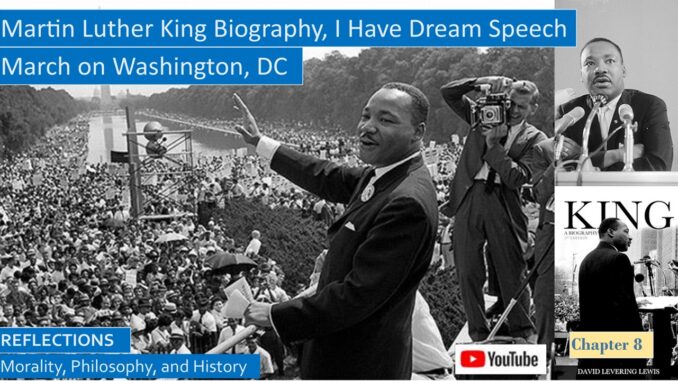
Today we are reflecting on Martin Luther King’s March on Washington and his inspirational “I Have a Dream” speech, drawing both from his speech and David Levering Lewis’ biography of Martin Luther King. We reflect on these questions:
Why was his “I Have a Dream” speech so memorable, so inspiring? What was its historical context? How did it respond to violence and bombings often faced by those seeking civil rights and justice for all citizens?
Did the March on Washington encourage the passage of the upcoming Civil Rights Act?
How did the 1963 March on Washington compare to the earlier planned march on Washington proposed by Philip Randolph during World War II, and the Marion Anderson concert, also in front of the Lincoln Memorial, sponsored by Eleanor Roosevelt?
YouTube video for this blog: https://youtu.be/IJ64y3nQA4Q
Script for this video, with Amazon book links: https://www.slideshare.net/slideshows/martin-luther-king-i-have-a-dream-speech-march-on-washington-dc-biography-chapter-8/265516499
PRIOR REFLECTIONS
Due to his rousing speeches, Martin Luther King was seen as the spokesman for the Civil Rights movement of the Sixties. He was great television.
Previously we have reflected on his youth and schooling, then the Montgomery Bus Boycott, when Martin Luther King first gained national prominence due to media attention. Next, he participated in the Lunch Counter and Freedom Rider protests, and then pursued Civil Rights in Albany, Georgia. Albany did not attract overwhelming media attention, but the brutality and bombing in Birmingham, where children were martyred, did bolster public support for the passage of the landmark Civil Rights Act of 1964.
Martin Luther King, Youth and Schooling, Lewis’ Biography Chapters, 1 and 2
https://seekingvirtueandwisdom.com/martin-luther-king-youth-and-schooling-lewis-biography-chapters-1-and-2/
https://youtu.be/_64FMZ6AlEg
Martin Luther King and Rosa Parks, Montgomery Bus Boycott, Lewis’ Biography, Chapter 3
https://seekingvirtueandwisdom.com/martin-luther-king-and-rosa-parks-montgomery-bus-boycott-lewis-biography-chapter-3/
https://youtu.be/TuiyFycWE-U
Martin Luther King, Lunch Counters, Freedom Riders, and Albany, Lewis’ Biography Chapters 4-6
https://seekingvirtueandwisdom.com/martin-luther-king-lunch-counters-freedom-riders-and-albany-lewis-biography-chapters-4-6/
https://youtu.be/_TLt2fQqL4w
What was in living memory for all Americans of voting age during the Civil Rights struggle of the Sixties, during the Presidencies of John F Kennedy and Lyndon Baines Johnson? Everyone remembered the end of World War II, which meant that the Nazi regime of Hitler had been defeated less than two decades ago. In addition to the Civil Rights struggle, what other event was happening that was also unimaginable without the experiences of the Great War?
Mussolini’s Fascist Regime and the Catholic Church
http://www.seekingvirtueandwisdom.com/mussolinis-fascist-regime-and-the-catholic-church/
https://youtu.be/LvNynEdZFuM
How the Catholic Church and the Confessing Church Survived Under Hitler’s Pagan Nazi Regime
http://www.seekingvirtueandwisdom.com/christians-under-hitlers-german-nazi-regime/
https://youtu.be/QP9UR8fqfvs
Spanish Civil War and the Catholic Church
http://www.seekingvirtueandwisdom.com/spanish-civil-war-and-the-catholic-church/
https://youtu.be/ozEioe6yyY8
Vichy France Regime, Blog 1, Pro-Life, Pro-Catholic, and Fascist
http://www.seekingvirtueandwisdom.com/vichy-france-regime-blog-1-pro-life-pro-catholic-and-fascist/
Vichy France, Blog 2, Collaborating with the Germans in the Early Years, 1940-1942
http://www.seekingvirtueandwisdom.com/vichy-france-blog-2-collaborating-with-the-germans-in-the-early-years-1940-1942/
Vichy France, Blog 3, The Tide Turns, Resistance and Collaboration
http://www.seekingvirtueandwisdom.com/vichy-france-blog-3-the-tide-turns-resistance-and-collaboration/
Vichy France, Blog 4, Christianity in Vichy France
http://www.seekingvirtueandwisdom.com/vichy-france-blog-4-christianity-in-vichy-france/
Vichy France in WWII: Pro-Fascist, Pro-Catholic, Pro-Life, Anti-Semitic
https://youtu.be/yYpNrhpmsYw
Pope Pius XII, Wartime Pope, Axis Powers March Across Europe
https://seekingvirtueandwisdom.com/pope-pius-xii-wartime-pope-axis-powers-march-across-europe/
https://youtu.be/L1bkOQNrlzg
Pope Pius XII, Wartime Pope, Allied Powers Turn the Tide of War
https://seekingvirtueandwisdom.com/pope-pius-xii-wartime-pope-allied-powers-turn-the-tide-of-war/
https://youtu.be/pjMa3JdjW48
Pope Pius XII, Wartime Pope, Could the Pope Have Done More To Save the Jews?
https://seekingvirtueandwisdom.com/pope-pius-xii-wartime-pope-could-the-pope-have-done-more-to-save-the-jews/
https://youtu.be/ONnAcLLBNog
How Did the Experiences of World War II Influence the Second Vatican Council?
https://seekingvirtueandwisdom.com/how-did-the-experiences-of-world-war-ii-influence-the-second-vatican-council/
https://youtu.be/QQEd9LDzV1U
That other struggle that dominated the news was the Second Vatican Council, in session from 1962 through 1965 under first Pope John XXIII, then Pope Paul VI. Two issues that dominated the sessions were rejecting anti-Semitism, and the debate about religious freedom, a distinctly American right, which also implied the embrace of democracy and the rejection of both fascist and communist authoritarianism. Anti-Semitism dominated Europe’s attention as much as Civil Rights was the center of attention in America, not only in Nazi Germany but also in fascist France and Italy.
What Happened at Vatican II, Embracing Democracy and Modernity
http://www.seekingvirtueandwisdom.com/what-happened-at-vatican-ii-embracing-democracy-and-modernity/
https://youtu.be/vHtYu6UtiuE
Vatican II Decree on Freedom of Religion, Embracing Democracy, Rejecting Fascism
http://www.seekingvirtueandwisdom.com/vatican-ii-decree-on-freedom-of-religion-embracing-democracy-rejecting-fascism/
https://youtu.be/i_zGeTW9QMI
Pope John XXIII Opening Address to Vatican II, and Yves Congar, True and False Reform, Conclusion
https://seekingvirtueandwisdom.com/pope-john-xxiii-opening-address-to-vatican-ii-and-yves-congar-true-and-false-reform-conclusion/
https://youtu.be/ALZozpbSrM4
Council of Trent, The Reform Council Foreshadowing Vatican II
http://www.seekingvirtueandwisdom.com/council-of-trent-the-reform-council-foreshadowing-vatican-ii/
https://youtu.be/Thq1blvzWHs
Our author, David Levering Lewis, compared the upcoming March on Washington to the black leader Phillip Randolph’s threat to stage a massive demonstration in Washington, DC at the start of World War II, which was called off when FDR ensured that more blacks would be employed in the wartime factories. Indeed, Philip Randolph suggested to Martin Luther King that he plan his March on Washington as a repeat of his planned march many decades before.
The March on Washington was also a replay of the Marion Anderson concert in 1939. She was a black opera singer who was denied use of concert halls in Washington DC for her concerts, First Lady Eleanor Roosevelt invited her to sing for the public facing the Reflecting Pool, in front of the Lincoln Memorial. Both events gave blacks hope that better times were ahead for their race.
Early Civil Rights Era, Through World War II Era: Yale Lecture Notes
http://www.seekingvirtueandwisdom.com/american-civil-rights-history-yale-lecture-notes/
https://youtu.be/weGmYOe0Lyg
MARCH ON WASHINGTON IS ORGANIZED
During this time, Martin Luther King closed a speech: “I say good night to you by quoting the words of an old Negro slave. We ain’t what we ought to be and we ain’t what we want to be. But thank God we ain’t what we was.”
Martin Luther King believed in nonviolence as a tactic: “It disarms your opponent, exposing his moral defenses.” “If he doesn’t beat you, wonderful! But if he beats you, you develop the quiet courage of accepting blows without retaliating. If he doesn’t put you in jail, wonderful! But if he puts you in jail, you go in that jail and transform it from a dungeon of shame to a haven of freedom and unity.” “If a man hasn’t discovered something that he will die for, he isn’t fit to live!”
Lewis writes in his biography, “Philip Randolph formally proposed to the five major civil rights organizations that an army of black plaintiffs be sent to Washington to demand the enactment of fair employment legislation and the passage of an increased minimum wage,” extending it to agriculture. Though some of these organizations were not initially enthusiastic, the March on Washington picked up steam when Kennedy’s civil rights bill was endangered due to a threatened filibuster in the Senate.
When John F Kennedy worried that the protests might degenerate into violence, Philip Randolph simply replied: “The Negroes are already in the streets. It is very likely impossible to get them off. If they are bound to be in the streets in any case, is it not better that they be led by organizations dedicated to civil rights and disciplined by struggle rather than to leave them to other leaders who care neither about civil rights nor nonviolence?”
In the summer of 1963, the heads of many civil rights organizations met in New York, including Martin Luther King of SCLC, John Lewis of SNCC, and also the leaders of the NAACP, CORE, and the Urban League. Also attending were Jewish rabbis, Protestant and Catholic clergy, and Walter Reuther of the UAW, or United Auto Workers.
The organizers and the Park Service were anticipating 150,000 participants, but about 250,000 attended, about a third were white. Entertainment was planned for the participants, including Joan Baez, John Dylan, Peter, Paul and Mary, and others, which helped guarantee that this would be a peaceful gathering. The March leaders met with members of Congress that morning, and with President Kennedy after the event. Ten speakers from the civil rights organizations were planned. Martin Luther King’s “I Have a Dream” was the last speech.
The speakers were careful not to criticize President Kennedy, but they did soften up John Lewis’ speech, which initially threatened that “the next time we march, we won’t march on Washington, but we will march through the South, through the heart of Dixie, the way General Sherman did” on his march through Georgia, where he burned, pillaged, and destroyed the countryside. Instead, Lewis changed this to say that he would “march through the South, through the streets of Danville” and Cambridge and Birmingham. “But we will march with the spirit of love” and “dignity that we have shown here today.”
In his speech, Roy Wilkins of the NAACP suggested that the pending civil rights bill and other legislation would include:
- Desegregated public transportation, including buses.
- Integrated education, voting rights for blacks, and better housing.
- “Fair Employment Practices Act to bar federal, states, city, and private employers, unions, and contractors from job discrimination.”
- A minimum wage of not less than two dollars an hour, equivalent to nineteen dollars an hour in 2022.
- “Federal programs to train and place unemployed workers.”
- Provisions to enable federal agencies to enforce these rights.
MARTIN LUTHER KING’S “I HAVE A DREAM” SPEECH
MLK’s “I Have a Dream” Speech begins:
“Five score years ago, a great American, in whose symbolic shadow we stand today, signed the Emancipation Proclamation. This momentous decree came as a great beacon light of hope to millions of Negro slaves who had been seared in the flames of withering injustice. It came as a joyous daybreak to end the long night of their captivity.”
“But a hundred years later, the Negro still is not free. One hundred years later, the life of the Negro is still sadly crippled by the manacles of segregation and the chains of discrimination. One hundred years later, the Negro lives on a lonely island of poverty in the midst of a vast ocean of material prosperity. One hundred years later the Negro is still languishing in the corners of American society and finds himself in exile in his own land. We have come here today to dramatize a shameful condition. In a sense, we’ve come to our nation’s capital to cash a check.”
Second Founding: The Reconstruction Amendments to the Constitution, by Eric Foner
http://www.seekingvirtueandwisdom.com/second-founding-the-reconstruction-amendments-to-the-constitution/
https://youtu.be/UciDV5laOLg
Post-Civil War Reconstruction and Redemption History, Yale Lecture Notes
http://www.seekingvirtueandwisdom.com/post-civil-war-reconstruction-and-redemption-history-yale-lecture-notes/
https://youtu.be/f5nPNnvDBCY
Civil Rights Era, Sixties and Beyond: Yale Lecture Notes
http://www.seekingvirtueandwisdom.com/american-civil-rights-history-yale-lecture-notes/
https://youtu.be/GQesHoV5IdI
MLK’s Dream continues, “When the architects of our republic wrote the magnificent words of the Constitution and the Declaration of Independence, they were signing a promissory note to which every American was to fall heir. This note was a promise that all men: YES, Black men as well as white men, would be guaranteed the unalienable rights of life, liberty, and the pursuit of happiness.”
“It is obvious today that America has defaulted on this promissory note insofar as her citizens of color are concerned. Instead of honoring this sacred obligation, America has given the Negro people a bad check, a check which has come back marked insufficient funds.”
MLK’s Dream continues, “But we refuse to believe that the bank of justice is bankrupt.”
“We refuse to believe that there are insufficient funds in the great vaults of opportunity of this nation. And so, we’ve come to cash this check, a check that will give us upon demand the riches of freedom and the security of justice.”
Martin Luther King is also using language reminiscent of Lincoln’s Gettysburg Address:
“We have also come to his hallowed spot to remind America of the fierce urgency of now. This is no time to engage in the luxury of cooling off or to take the tranquilizing drug of gradualism.”
MLK’s Dream continues, “Now is the time to make real the promises of democracy. Now is the time to rise from the dark and desolate valley of segregation to the sunlit path of racial justice. Now is the time to lift our nation from the quick sands of racial injustice to the solid rock of brotherhood. Now is the time to make justice a reality for all of God’s children.”
“It would be fatal for the nation to overlook the urgency of the moment. This sweltering summer of the Negro’s legitimate discontent will not pass until there is an invigorating autumn of freedom and equality. 1963 is not an end, but a beginning. Those who hope that the Negro needed to blow off steam and will now be content will have a rude awakening if the nation returns to business as usual.”
Although many white liberals were concerned that Martin Luther King was going too fast in his protests and demands, there were many activists more radical than he, including the student organization SNCC that he helped form, and militants like Malcolm X. His supporters egged Martin’s car when he was in Harlem.
MLK’s Dream continues, “There will be neither rest nor tranquility in America until the Negro is granted his citizenship rights. The whirlwinds of revolt will continue to shake the foundations of our nation until the bright day of justice emerges.”
“But there is something that I must say to my people who stand on the warm threshold which leads into the palace of justice. In the process of gaining our rightful place, we must not be guilty of wrongful deeds. Let us not seek to satisfy our thirst for freedom by drinking from the cup of bitterness and hatred.”
Martin Luther King reminds his audience of the need for nonviolent tactics:
“We must forever conduct our struggle on the high plane of dignity and discipline. We must not allow our creative protest to degenerate into physical violence. Again and again, we must rise to the majestic heights of meeting physical force with soul force. The marvelous new militancy which has engulfed the Negro community must not lead us to a distrust of all white people, for many of our white brothers, as evidenced by their presence here today, have come to realize that their destiny is tied up with our destiny.”
But Martin Luther King also emphasizes that civil rights activists should never give up and should never waver in their dedication:
“And they have come to realize that their freedom is inextricably bound to our freedom. We cannot walk alone. And as we walk, we must make the pledge that we shall always march ahead. We cannot turn back.”
MLK’s Dream continues: “There are those who are asking the devotees of civil rights, when will you be satisfied? We can never be satisfied as long as the Negro is the victim of the unspeakable horrors of police brutality. We can never be satisfied as long as our bodies, heavy with the fatigue of travel, cannot gain lodging in the motels of the highways and the hotels of the cities.”
When can blacks be satisfied? MLK proclaims:
“We cannot be satisfied as long as the Negro’s basic mobility is from a smaller ghetto to a larger one. We can never be satisfied as long as our children are stripped of their selfhood and robbed of their dignity by signs stating: FOR WHITES ONLY.”
“We cannot be satisfied as long as a Negro in Mississippi cannot vote and a Negro in New York believes he has nothing for which to vote.”
“No, no, we are not satisfied, and we will not be satisfied until justice rolls down like waters, and righteousness like a mighty stream.”
Martin Luther King reminded his listeners that unjust laws must be challenged, that the Freedoms of Speech and Assembly implies a freedom to protest, a freedom that had been recently confirmed by the Supreme Court during the Birmingham struggle.
MLK’s Dream continues: “I am not unmindful that some of you have come here out of great trials and tribulations. Some of you have come fresh from narrow jail cells. Some of you have come from areas where your quest for freedom left you battered by the storms of persecution and staggered by the winds of police brutality. You have been the veterans of creative suffering.”
“Continue to work with the faith that unearned suffering is redemptive. Go back to Mississippi, go back to Alabama, go back to South Carolina, go back to Georgia, go back to Louisiana, go back to the slums and ghettos of our Northern cities, knowing that somehow this situation can and will be changed.”
“Let us not wallow in the valley of despair, I say to you today, my friends.”
MARTIN LUTHER KING’S “I HAVE A DREAM” REFRAIN
Some have claimed that Martin Luther King went off-script in his “I Have a Dream” refrains. But he had been trying out this refrain in previous speeches. Other speeches listed the demands of the movement, but Martin instead chose to inspire with his speech, and this is indeed one of the most memorable speeches in modern history.
The refrains begin with phrases from the Gettysburg Address:
“So even though we face the difficulties of today and tomorrow, I still have a dream. It is a dream deeply rooted in the American dream. “I Have a Dream that one day this nation will rise up and live out the true meaning of its creed: We hold these truths to be self-evident, that all men are created equal.”
Pericles Funeral Oration & Plague, Lincoln Gettysburg Address, Churchill Battle of Britain Speech
https://seekingvirtueandwisdom.com/pericles-funeral-oration-plague-lincoln-gettysburg-address-churchill-battle-of-britain-speech/
https://youtu.be/wyjWBAG6xrc
MLK looks peers into the future: “I Have a Dream that one day on the red hills of Georgia, the sons of former slaves and the sons of former slave owners will be able to sit down together at the table of brotherhood.”
“I Have a Dream that one day even the state of Mississippi, a state sweltering with the heat of injustice, sweltering with the heat of oppression, will be transformed into an oasis of freedom and justice.”
More blood would be drawn in Mississippi, as the local police in league with the KKK would murder both black and white students who were registering voters in Mississippi.
MLK proclaims: “I Have a Dream that my four little children will one day live in a nation where they will not be judged by the color of their skin but by the content of their character. “I Have a Dream today.”
“I Have a Dream that one day down in Alabama with its vicious racists, with its governor having his lips dripping with the words of interposition and nullification, one day right down in Alabama little Black boys and Black girls will be able to join hands with little white boys and white girls as sisters and brothers. “I Have a Dream today.”
Blood had already been drawn in Alabama, including the death by dynamite of four young girls attending Sunday School in a black church.
MLK’s Dream continues: “I Have a Dream that one day every valley shall be exalted, every hill and mountain shall be made low, the rough places will be made plain, and the crooked places will be made straight, and the glory of the Lord shall be revealed, and all flesh shall see it together.”
“This is our hope. This is the faith that I go back to the South with. With this faith, we will be able to hew out of the mountain of despair a stone of hope. With this faith, we will be able to transform the jangling discords of our nation into a beautiful symphony of brotherhood. With this faith we will be able to work together, to pray together, to struggle together, to go to jail together, to stand up for freedom together, knowing that we will be free one day.”
MLK’s Dream continues: “This will be the day when all of God’s children will be able to sing with new meaning: My country, ’tis of thee, sweet land of liberty, of thee I sing. Land where my fathers died, land of the pilgrims’ pride, from every mountainside, let freedom ring.”
MLK concludes his Dream: “And if America is to be a great nation, this must become true. And so let freedom ring from the prodigious hilltops of New Hampshire. Let freedom ring from the mighty mountains of New York. Let freedom ring from the heightening Alleghenies of Pennsylvania. Let freedom ring from the snowcapped Rockies of Colorado. Let freedom ring from the curvaceous slopes of California. But not only that, let freedom ring from Stone Mountain of Georgia. Let freedom ring from Lookout Mountain of Tennessee. Let freedom ring from every hill and molehill of Mississippi. From every mountainside, let freedom ring.”
What is ironic is that on the face of Stone Mountain, the most visited tourist attraction in Georgia, are carved the portraits of Confederate President Jefferson Davis, and Confederate Generals Robert E Less and Stonewall Jackson. This is a pilgrimage site for white supremacists and members of the Ku Klux Klan. Stone Mountain Park is owned by the state of Georgia.
Martin Luther King finishes his Dream: “And when this happens, and when we allow freedom ring, when we let it ring from every village and every hamlet, from every state and every city, we will be able to speed up that day when all of God’s children, Black men and white men, Jews and Gentiles, Protestants and Catholics, will be able to join hands and sing in the words of the old Negro spiritual: Free at last. Free at last. Thank God almighty, we are free at last.”
REACTIONS TO THE “I HAVE A DREAM” SPEECH
After every speech, the news commentators always remark that it did not move the needle of public opinion. What this impatience misses is that politics is like relationships: over a long period of time they will either improve, or they will deteriorate. We should always seek that they improve.
As Hubert Humphrey noted after the speech: “All this probably hasn’t changed any votes on the civil rights bill, but it is a good thing for Washington and the nation and the world.” And people all around the world were also watching these events unfold on their television sets.”
John F Kennedy issued this statement: “We have witnessed today in Washington tens of thousands of Americans, both Negro and white, exercising their right to assemble peacefully and direct the widest possible attention to a great national issue.”
A few months later, in November, President John F Kennedy was assassinated in his motorcade in Dallas, Texas, with his brains spilling out of his skull as it rested on the lap of the First Lady Jacqueline Kennedy. Martin Luther King wrote in Look magazine, “JFK was at his death undergoing a transformation from a hesitant leader to a strong figure with deeply appealing objectives.”
JFK’s assassination, combined with MLK’s “I Have a Dream” speech, both accelerated the progress of the civil rights legislation in Congress. This unfortunate event also contributed to it’s passing, as our biographer Lewis notes: “Martin believed that cruel chance had devised the ultimate civil rights weapon, a presidential voice that spoke in a Southern drawl.” LBJ was a highly effective congressman, rising to become Senate Majority Leader before he was chosen to be Vice President, and vigorously cajoled the passage of the Civil Rights Bill of 1964.
As Lewis recounts: “As 1963 drew to a close, the stature of Martin Luther King continued to grow.” In January 1964, the calm, directed gaze of Martin Luther King graced the cover of Time magazine again. He had been chosen Man of the Year, the second black man since Emperor Haile Selassie to receive this honor.”
The Time magazine was flattering. “Few can explain the King mystique, yet he has an indescribable capacity for empathy that is the touchstone of leadership. By deed and by preaching, he has stirred in his people a Christian forbearance that nourishes hope and smothers injustice.”
In a speech in Europe in December 1964, Martin Luther King proclaimed, “I accept the Nobel Prize for Peace at a moment when twenty-two million Negroes in America are engaged in a creative battle to end the long night of racial injustice.” “I am mindful that debilitating and grinding poverty afflicts my people and chains them to the lowest rung of the economic ladder.”[1]
After the March on Washington and Martin Luther King’s “I Have a Dream” speech, he faced more bloody struggles against white supremacists first in St Augustine, then in registering voters in Mississippi, then facing more police dogs and brutality in the famous march on Selma, followed by his fight for more equitable housing in Chicago. Finally, his life was cut short by his assassination in Memphis.
yt
DISCUSSING THE SOURCES
The author, David Levering Lewis, was planning to write the biography of Martin Luther King when he was assassinated. It was initially published a year later and quickly became the classic biography of this Civil Rights icon. We discussed his biography in greater depth in our reflection on his youth and school years.
Martin Luther King, Youth and Schooling, Lewis’ Biography Chapters, 1 and 2
https://seekingvirtueandwisdom.com/martin-luther-king-youth-and-schooling-lewis-biography-chapters-1-and-2/
https://youtu.be/_64FMZ6AlEg
Lewis also wrote the definitive biography for WEB Du Bois. We also recommend the Time magazine article for another readable biography of Martin Luther King.
https://content.time.com/time/subscriber/article/0,33009,940759-1,00.html
[1] David Levering Lewis, KING, a Biography (Chicago, Illinois, University of Illinois Press, 2013, 1970), Chapter 8, pp. 210-239, 262 and https://en.wikipedia.org/wiki/Stone_Mountain

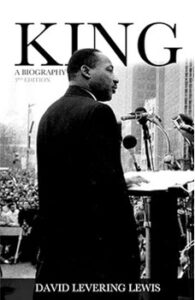
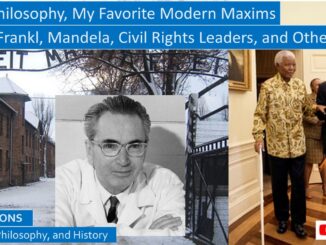
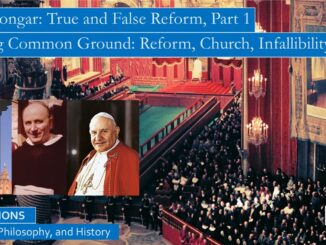
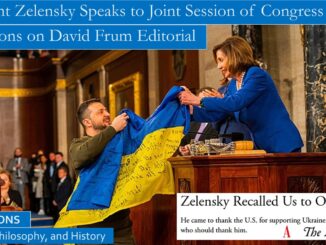
4 Trackbacks / Pingbacks